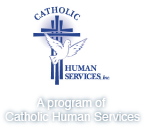Explanation of Adoption Fees
We recognize that the costs of adoption are formidable and constitute a major challenge to most household budgets. The expenses related to adoption are not covered by insurance and often come on the heels of monstrous medical expenses related to infertility treatment. All that tends to make people rather tender on financial issues, and this is why it is important that we communicate clearly on the expense of adoption.
FEDERAL TAX CREDIT: Wonderfully, the federal government has provided in recent years a sizeable credit for adoption expenses for middle income families.
NON-PROFIT ORGANIZATION: We are convinced that the most appropriate context for adoption services is the non-profit agency. Non-profit means our services are non-commercial. Staff members receive reasonable salaries and are not motivated by the prospect of profit.
CHARITABLE SUPPORT: Our pregnancy/adoption program is partially underwritten by the Catholic Service Appeal. All the participants in our program benefit from this support.
COMMUNITY ACCOUNTABILITY: We are accountable to communities in general and our board of directors in particular. Because of the potential for unscrupulous organizations to exploit the supply and demand disequilibrium in adoption, the State of Michigan adds the statutory protection of judicial review of adoption fees.
THE AGENCY CONTEXT: People entering our program enter a larger system. The agency brings the advantages of respectability, continuity and stability, broader connections, and supervision. With these advantages come the responsibilities of overhead expenses.
COLLECTIVE SHARING: It is very tempting for all of us to simplistically link fees to particular services provided. While there needs to be some connection, experience suggests it is an error to take that logic too far. If too tight a link between service and fee were established, the expenses of adoption would lose all predictability because some cases are far more involved than others. By spreading the exceptional expenditures (travel, potential adoptions that do not go forward, material aid to birth families, etc.) across the entire pool of families, no single family faces the prospect of an extraordinarily expensive adoption. The pooling of resources is one of the great benefits of working with our agency.
SUBSEQUENT ADOPTIONS: Families returning to adopt additional children through the program require significantly less evaluation and preparation. This means that returning families help to keep the costs down for first time families.
STATE OF MICHIGAN SUPPORT: The State keeps adoption expenses in line in two significant ways. First, it offers an excellent program for “special needs” adoptions. By attending to the most difficult adoptive situations with tax dollars, the State spares agencies from having to factor the most expensive adoptions into their average costs. Second, the Medicaid program through the Department of Human Services picks up the medical expenses of children who are adopted and also covers the medical expenses of many uninsured birthmothers, expenses which adoptive parents are often expected to cover in other states.
POST-PLACEMENT SERVICES: Our program has some enduring obligations to the people it serves. We enjoy offering this service because it is the right thing to do. We learn for the future by gathering feedback from the past and we welcome back all our adoptive and birth families as “clients for life”. Costs for those post adoptive services are covered by current clients.
COMMITMENT TO EXCELLENCE: This is not an average program. We have been on the leading edge of progress for decades and we intend to stay there. Most of the participants in the program revel in this commitment and add to it. If we are to offer a state of the art program, there are expenses related to research and development costs that must be covered.
PUBLIC AWARENESS: Times are changing swiftly in the world of adoption, and there is ferocious competition to capture the attention of potential birthparents. It is no longer sufficient to simply offer a quality program. These days our program must be proactive and work hard to bring its message to the general public. This new dimension brings new financial challenges.

